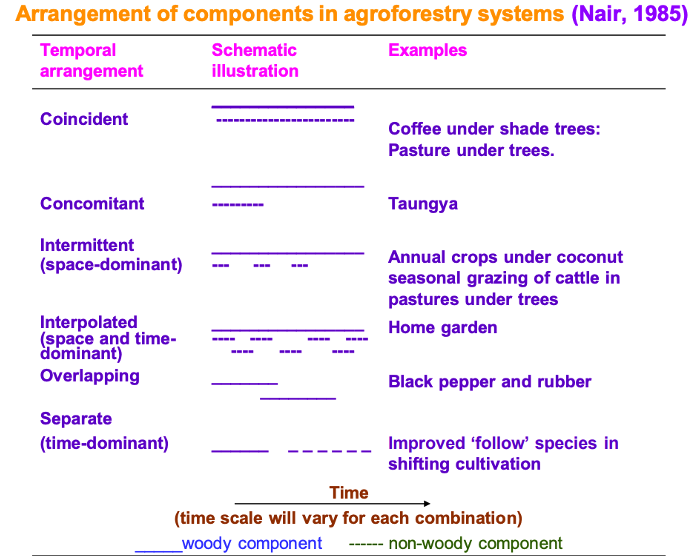🔲 Agroforesty Systems
Spatial & Temporal Arrangement
Based Arrangement of Components
- The arrangement of components gives first priority to the plants.
- Even in AF systems involving animals, their management according to definite plan, say a rotational grazing scheme, gives precedence to the plants over the animals. Such plants arrangements in multispecies combinations involve the dimensions of
spaceandtime.
Spatial arrangement
👉🏻 Spatial arrangement of plant in agroforestry mixture may result in
- Dense mixed stands e.g., home gardens
- Sparse mixed stands e.g., most systems of trees in pastures
- The species (or species mixture may be laid out in zones or strips)
- Zonal arrangement - microzonal, macrozonal
- A common example of the zonal pattern is hedge intercropping
- An extreme form of the zonal arrangement is the boundary planting of trees on edges of plots for fruits, fodder, fuel wood, fencing, soil protection and windbreak.
- An extreme term of macrozonal arrangement can laid to sole cropping system but the interactions association of different components can be used criteria to decide like limits between zonal AF and sole crop (component) plots.
Temporal arrangement
- Temporal arrangement of plant in agroforestry systems can take various forms such as

- Coincident: When two components woody and non-woody occupy the land together as coffee under shade tree and pasture under shade trees.
- Concomitant: When two components woody or non woody stays together for some part of life as in taungya.
- Intermittent (Space dominated): When annual crops are grown with perennial crops such as paddy with coconut.
Interpolated (Space and time dominant): When different components occupy space during different time as inhome gardenPre PG 2020.- Separate (time-dominant): When components occupy space during separate time such as improved fallow species in
shifting cultivation.
Functional Basis
👉🏻 All agroforestry systems have two functions.
A) Productive functions
👉🏻 The Productive functions are:
- Food
- Fodder
- Fuel wood
- Cloths
- Shelter
- NTFPs
B) Protective functions
👉🏻 The Protective functions are:
- Wind breaks
- Shelterbelts
- Soil conservation
- Soil improvement
Socio-Economic Classification
- Based on socioeconomic criteria as scale of production and level of technology input and management, agroforestry systems have been grouped in to three categories.
A) Commercial AF systems
- The term commercial is used whenever the scale of the production of the output is the major aim of the system.
- Examples:
- Oil Palm plantation in Manipur
- Rubber plantation in Kerala
- Coconut plantation in south India
- Poplar plantation in Tarai
B) Intermediate AF systems
- Intermediate systems are those between commercial and subsistence scale of production and management.
- Examples: Production of perennial cash crops and subsistence food crops undertaken on farms wherein the cash crops fulfill the cash needs and the food crops meet the family‘s food needs.
C) Subsistence AF systems
- Subsistence AF systems are those wherein the use of land is directed towards satisfying basic needs and is managed mostly by the owner and his family.
Ecological Classification
- Refers to the environmental condition and ecological suitability of systems, based on the assumption that certain types of systems can be more appropriate for certain ecological conditions, i.e., there can be separate sets of agroforestry systems for arid and semiarid lands, tropical highlands, lowland humid tropics, etc.

Based Arrangement of Components
- The arrangement of components gives first priority to the plants.
- Even in AF systems involving animals, their management according to definite plan, say a rotational grazing scheme, gives precedence to the plants over the animals. Such plants arrangements in multispecies combinations involve the dimensions of
spaceandtime.
Spatial arrangement
👉🏻 Spatial arrangement of plant in agroforestry mixture may result in
- Dense mixed stands e.g., home gardens
- Sparse mixed stands e.g., most systems of trees in pastures
- The species (or species mixture may be laid out in zones or strips)
- Zonal arrangement - microzonal, macrozonal
- A common example of the zonal pattern is hedge intercropping
- An extreme form of the zonal arrangement is the boundary planting of trees on …
Become Successful With AgriDots
Learn the essential skills for getting a seat in the Exam with
🦄 You are a pro member!
Only use this page if purchasing a gift or enterprise account
Plan
Rs
- Unlimited access to PRO courses
- Quizzes with hand-picked meme prizes
- Invite to private Discord chat
- Free Sticker emailed
Lifetime
Rs
1,499
once
- All PRO-tier benefits
- Single payment, lifetime access
- 4,200 bonus xp points
- Next Level
T-shirt shipped worldwide

Yo! You just found a 20% discount using 👉 EASTEREGG

High-quality fitted cotton shirt produced by Next Level Apparel